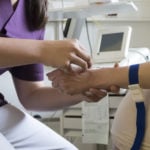
LPN Role During a Code Blue

Nurses are often the first responders to Code Blues. They are the ones at the bedside around the clock, and the ones who first notice signs of clinical deterioration. Nurses play an important role during Code Blues, including LPNs.
Starting with the basics, LPNs may initiate CPR per BLS guidelines. Checking for the presence or absence of a pulse or respiration is well within the scope of an LPN, as is initiating CPR. IV certified LPNs may start a line if not already established. They may also obtain supplies for physicians, RNs, or other members of the code team. Ensuring LPNs are familiar with emergency equipment and crash carts are essential in LPNs working to their full potential in emergency situations.
LPNs may also help to direct traffic. During a Code Blue, many responders arrive including nurses, physicians, anesthesiologists, security, and even administration. LPNs can help direct staff where to go as well as manage overcrowding. Along these same lines, LPNs can help protect patient privacy by ensuring curtains are pulled, and non-essential staff and visitors are directed away from the code.
While LPNs cannot administer IV medications, they may start IV infusions (if IV certified), administer oxygen, draw blood, and obtain a fingerstick blood glucose check if needed. This frees up advanced life support practitioners to perform more invasive procedures such as intubation, administer IV medications, and transfuse blood.
LPNs may also act as “recorder,” documenting the events during the code, recording medications and treatments that are administered, and list staff who responded to the code. Documentation is critical during as physicians, administrators, and managers refer to it later for learning and quality improvement purposes.
LPNs may also assist in transporting patients to a higher level of care. They can help gather patient belongings and equipment and assist the RN in moving the patient to a different unit in the hospital. In the outpatient setting, they can help with ER or EMS transport as well by ensuring all belongings are with the patient, and transporting staff have critical patient information on hand.
Lastly, LPNs can provide emotional support to family members of the patient. Leading the family to a quiet, calm environment and explaining what is happening is critical to the well-being of families.
Every member of the healthcare team is essential to the overall success of the code. Clarifying roles and having clear expectations of duties leads to the best outcome for patients, which may help save a life during an emergency.
Related Articles
Featured Article





